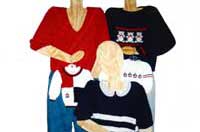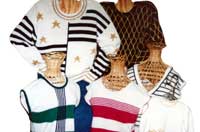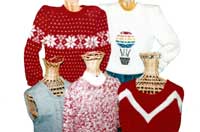



I started doing this when I was custom knitting and didn’t have time to knit swatches all day long trying to get the correct gauge. Now, I still don’t want to knit swatches, but I want to knit sweaters that fit me! I hope this will help each of you to be able to knit sweaters easier and not have to worry about getting the gauge in the books!
I normally wear a size 36, but by using the following method, I can make anywhere from a children’s size 10 to a women’s size 50 for myself. You too can do this with my books since I have so many different sizes in them.
When making a swatch, knit it at the tension you think the sweater will feel the nicest. Let the swatch rest over night, then measure for sts and rows per inch.
You are now ready to find out what size of sweater you are going to knit. But remember, don’t worry about what size it says, just the number of sts to cast on.
A = Bust or Chest measurement + ease ÷ 2 x sts per inch = number of sts to cast on.
B = Length from bottom rib to underarm x rows per inch.
C = Length from shoulder to underarm + 1" x rows per inch.
Go to any of my books and find the diagrams with the number of sts that you need to cast on for the bust measurement (A). Make sure you use the numbers at the bottom of the sweater diagram, as this will be the widest part of the sweater.
You will now follow the pattern directly by the book, only changing the number of rows for length (B or C) if needed. The shaping will all stay the same.
If you have to add or subtract rows from the underarm to the shoulder, there are straight rows, with no decreasing, where I take them out or add them in. For example, you need 10 rows more to the shoulder than the book says. Knit following directions to the neck shaping, then knit the 10 rows extra. Reset your row counter back to the number that is called for and follow the neck and shoulder shaping out of the book. Do the same thing if you have to subtract rows. Subtract 10 rows from where you want the neckline to start, knit to that row, then reset to the number needed for the neck shaping.
I really hope this will help you to use the yarns that you really like, and not have to worry about the gauge. Please give it a try — I think you will really like it!!